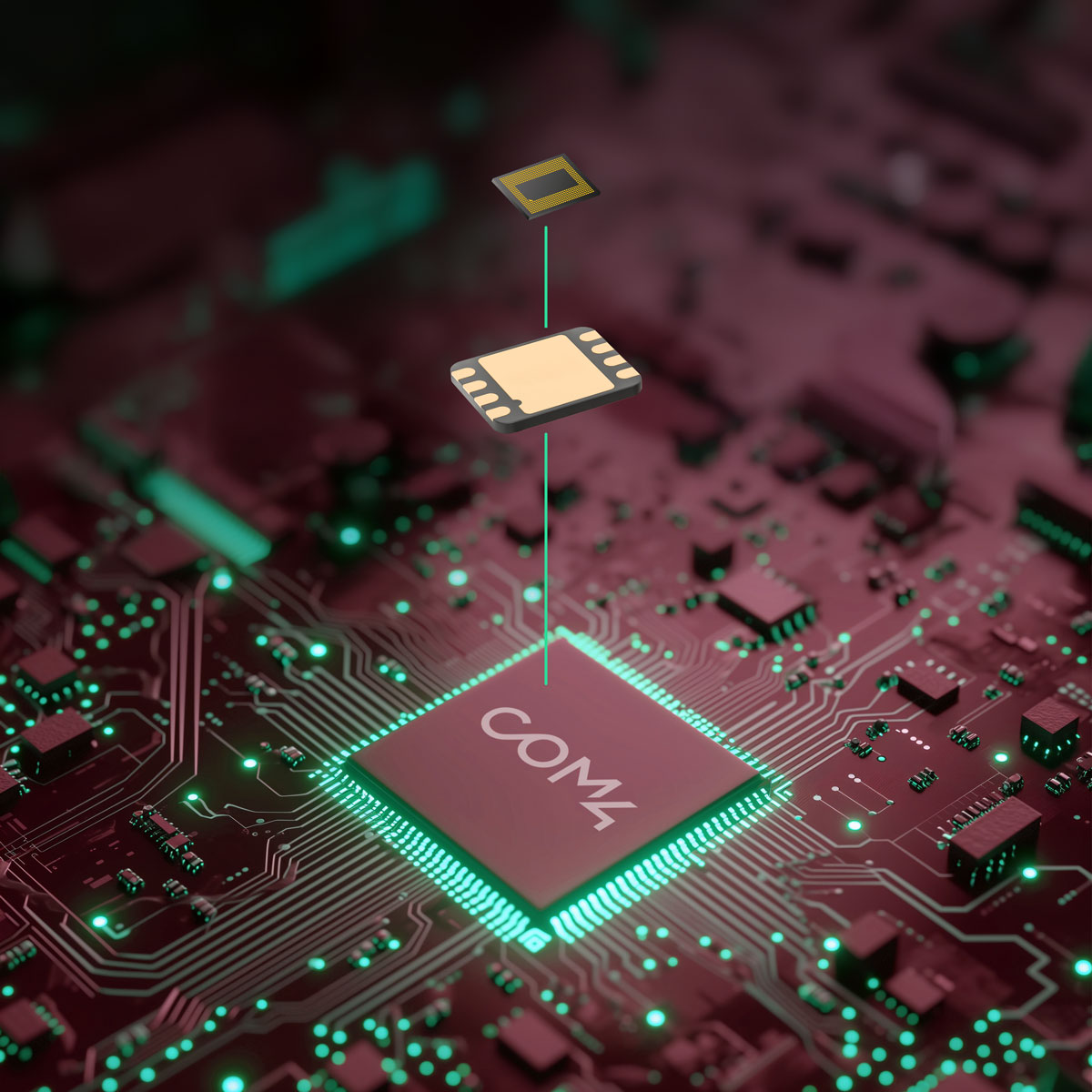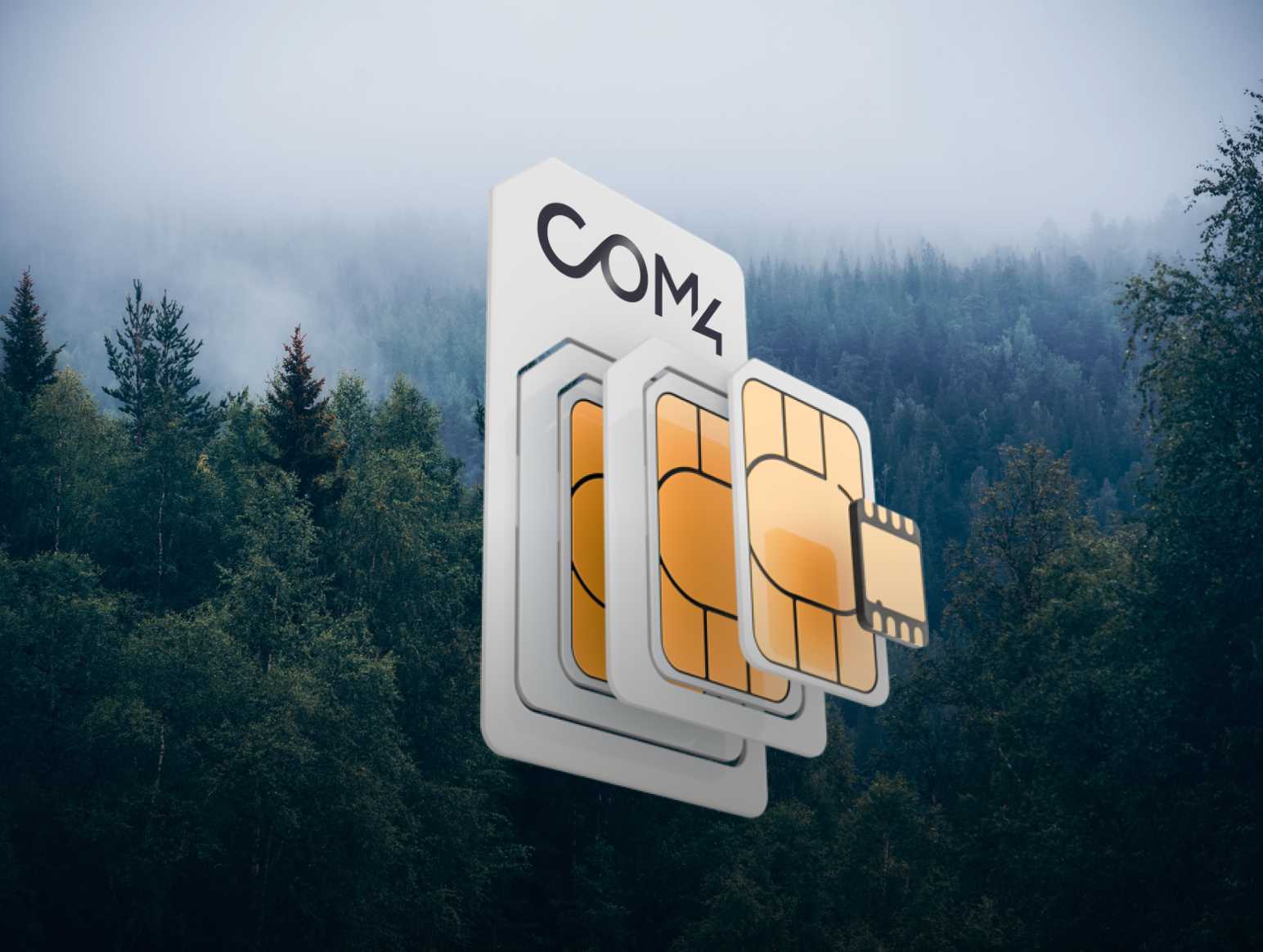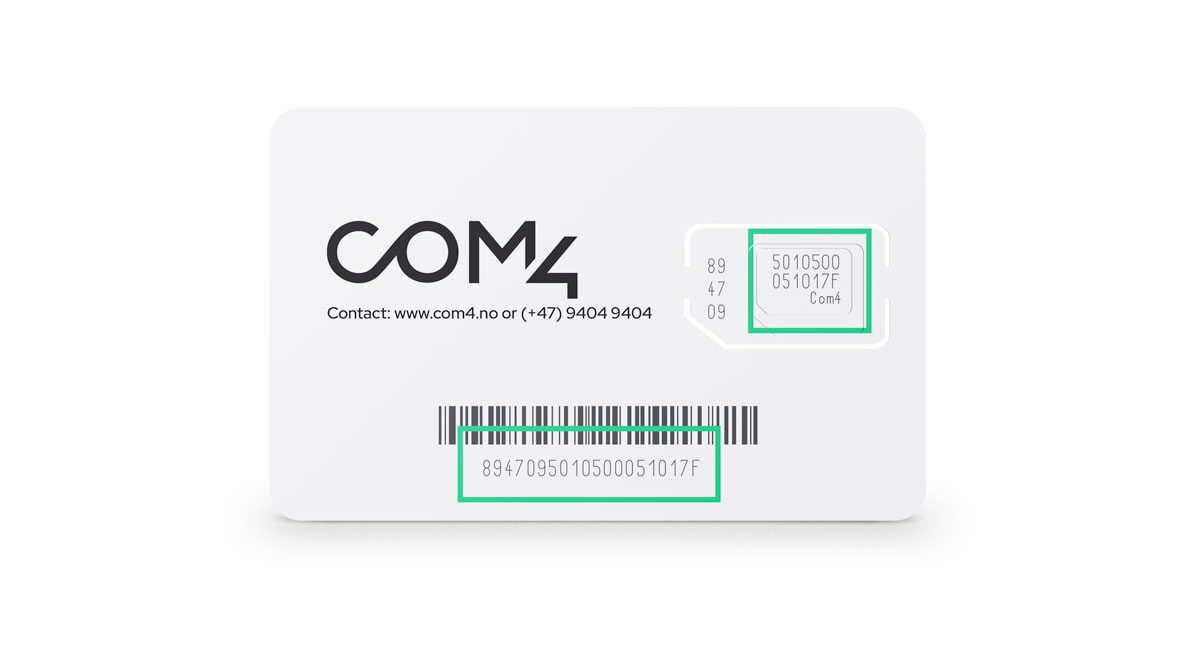Two newer technologies, eSIM and iSIM, are helping IoT innovators address these challenges. Both allow remote provisioning of network profiles and reduce the need for physical SIM management. Choosing between them depends on the type of devices, deployment scale and long-term strategy.
Com4 supports enterprises with both eSIM and iSIM solutions, including an iSIM Evaluation Kit that allows testing and development. This article explains the differences, the benefits, and how real IoT projects are already using them.
What is eSIM
An eSIM is an embedded SIM based on the eUICC standard. Instead of swapping physical cards, operators can add or change profiles remotely. This makes it easier to deploy devices globally, manage connectivity over time, and avoid costly site visits.
For IoT projects, eSIM means a single device can be shipped worldwide, and the network profile can be updated later. This reduces stock-keeping complexity and helps ensure longer device lifecycles.
Example in practice: MedThings uses Com4’s eSIM in healthcare devices to secure data-driven medication delivery. The flexibility of eSIM ensures reliable connectivity without constant manual intervention.
For businesses planning international rollouts, Com4 also offers Global IoT SIM cards and Connectivity Packages that integrate with eSIM management.
What is iSIM
iSIM, or integrated SIM, goes a step further by embedding SIM functionality directly into the device’s system-on-chip. This reduces the space needed on the hardware, lowers power consumption and improves tamper resistance.
iSIM is attractive for battery-powered IoT devices such as sensors, wearables, or asset trackers where space and energy are limited. While still at an earlier stage of adoption compared to eSIM, iSIM is gaining attention as chipsets from major vendors start to support it.
Com4 helps innovators test this technology with the iSIM Evaluation Kit. This kit provides developers with a practical way to explore iSIM capabilities before scaling.
Comparing eSIM and iSIM
Although both technologies enable remote provisioning, there are key differences that affect decision-making.
|
Feature |
eSIM |
iSIM |
Best suited for |
|
Form factor |
Embedded chip on device board |
Integrated in system-on-chip |
iSIM for ultra-compact devices |
|
Power use |
Low but higher than iSIM |
Very low standby power |
iSIM for battery-first designs |
|
Provisioning |
Remote via GSMA standards |
Remote but chipset dependent |
eSIM for broad compatibility |
|
Security |
Hardware secure element |
Built-in, more tamper resistant |
iSIM for sensitive use cases |
|
Ecosystem maturity |
Widely available |
Emerging, still growing |
eSIM for immediate rollouts |
For global IoT scale, eSIM currently offers broader device compatibility and operational maturity. iSIM is more future-facing, suited for innovators building the next generation of constrained IoT devices.
Business impact of SIM choice
Selecting the right SIM technology affects more than connectivity. It changes how devices are manufactured, shipped, and maintained.
With eSIM, businesses can manufacture a single device model and deploy it globally by downloading local network profiles later. This reduces inventory complexity and avoids the cost of handling different variants for each market. It also cuts down on field visits, since network changes can be managed remotely.
iSIM brings further advantages for devices where space and energy are limited. By integrating the SIM into the system-on-chip, manufacturers can design smaller hardware and extend battery life. This makes iSIM attractive for wearables, sensors, and other compact IoT devices where long service life in the field is critical.
Real-world examples:
- Intellity uses Com4 connectivity to secure construction sites in real time.
- Beehive improves child safety on trips through reliable IoT connections.
Both projects show how SIM flexibility and strong provisioning improve operations beyond just cost savings.
Security considerations
Both eSIM and iSIM follow GSMA standards, which include strong encryption and secure profile management. iSIM adds further protection by being integrated inside the chipset, making physical tampering harder.
For IoT deployments, this matters because devices often operate in uncontrolled environments such as public spaces, vehicles, or industrial sites. A secure SIM layer ensures that even if the device is accessed, connectivity credentials remain protected. Remote provisioning also allows businesses to revoke or replace profiles quickly if a security risk is identified.
Com4 strengthens this by offering IoT add-ons such as private APNs and VPN solutions. This ensures IoT traffic stays isolated, compliant and protected against misuse.
Cost and sustainability factors
Device costs are not only about hardware. Logistics, service visits, and battery replacement all add to total cost of ownership. eSIM already reduces truck rolls for SIM swaps. iSIM goes further with power efficiency, which prolongs battery life in sensors and trackers.
These benefits also contribute to sustainability. Fewer site visits mean lower fuel use, and longer device lifespans reduce electronic waste. For large-scale projects, this can make a measurable difference in both operating budgets and environmental impact.
Projects like Sensorita show how efficient connectivity helps reduce costs on construction sites while also supporting sustainability goals.
Migration and adoption checklist
IoT innovators considering eSIM or iSIM should follow a clear migration plan:
- Audit current devices and deployment regions: Start by identifying how many devices are in use and where they are deployed. This helps reveal which models may be affected by network sunsets or regional restrictions.
- Check chipset support for eSIM and iSIM: Not all hardware is ready for eSIM or iSIM, so confirm compatibility with your device vendors. For iSIM in particular, look for modules with integrated secure elements already validated by operators.
- Define provisioning requirements: Decide whether devices need single or multiple operator profiles, and how often profiles may need updating. For projects across borders, remote provisioning should support local compliance rules.
- Run pilot tests with eSIM or the iSIM Evaluation Kit: Pilots allow teams to test performance in real environments before scaling. With Com4’s iSIM Evaluation Kit, developers can measure power use, provisioning flows, and security behaviour directly.
- Analyse results and scale gradually with monitoring in place: After pilots, review metrics such as uptime, battery life, and provisioning success rates. Use these insights to adjust rollout strategies and refine device configurations. Scaling in phases with monitoring ensures early issues are caught before they affect large fleets.
Ecosystem readiness
Today, eSIM is widely available across devices in healthcare, transport and industrial sectors. This maturity means businesses can adopt eSIM with confidence, knowing devices and modules are already tested in real-world conditions.
iSIM is emerging, supported by new chipsets and modules, and is expected to grow rapidly as the industry aligns around integrated designs. Early adoption allows innovators to design products that stay competitive for longer lifecycles. Com4 supports this shift by providing test kits and practical guidance, helping enterprises validate iSIM in controlled pilots before committing to large-scale deployments.
Decision guide
When to choose eSIM
Select eSIM if you need wide device support and immediate global scalability. It works well for projects that must launch quickly in multiple regions, such as healthcare or logistics, because devices can be provisioned with local operator profiles remotely. eSIM is also a safe option if you rely on established hardware vendors that already ship modules with proven eUICC support.
When to choose iSIM
Choose iSIM if you are designing new, compact, or battery-sensitive devices and want to prepare for the future. It is especially suited to sensors, wearables and other constrained devices where every millimetre of space and every milliamp of power counts. Early adoption of iSIM also allows innovators to build products that remain competitive as operators and chipset makers expand support.
Com4 provides both, supported by Global IoT coverage with access to 750 networks in 190 countries. This ensures whichever SIM technology you adopt, your devices remain connected worldwide. To discuss your IoT connectivity strategy, contact Com4 and start shaping your connected future.
For IoT innovators, the choice between eSIM and iSIM is not about which is better, but which suits your project requirements today and tomorrow. eSIM offers maturity and broad support, while iSIM delivers efficiency and security for the next wave of IoT devices.Com4 enables enterprises to explore both paths. With solutions such as Global IoT SIM cards and the iSIM Evaluation Kit, businesses can test, pilot and scale with confidence.
FAQ
Can a single IoT device support both eSIM and iSIM?
Not in the same hardware design. eSIM requires a separate embedded chip, while iSIM is integrated into the device’s main chipset. However, enterprises can plan device families where some models use eSIM and newer models move to iSIM as chipsets evolve.
Is iSIM only relevant for new devices?
How does remote provisioning actually work in practice?
Remote provisioning uses secure servers defined by GSMA standards to deliver and manage SIM profiles. This allows businesses to activate or switch operators over-the-air without recalling devices. With Com4’s management tools, profiles can be added, updated, or retired securely at scale.
Does iSIM improve device security compared to eSIM?
Both eSIM and iSIM meet GSMA security standards. iSIM can provide an additional layer of protection by being embedded into the chipset, which makes physical tampering more difficult. For industries handling sensitive data, this can be an important consideration.
What should a company pilot first: eSIM or iSIM?
It depends on the timeline. If the project requires immediate deployment with existing modules, piloting eSIM makes sense. If the project is in early development and involves compact or battery-powered devices, piloting iSIM with an evaluation kit provides long-term benefits.

 CASE STUDY
CASE STUDY



.png?width=1200&height=630&name=2%20iSIM%201-91_1%20(2).png)
.jpg?width=1200&height=628&name=SIMS%20(2).jpg)




